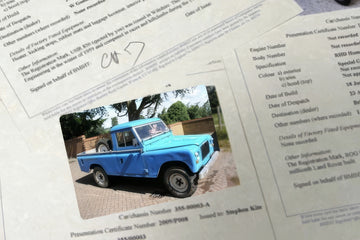Introduction
Owning a classic Land Rover is like possessing a piece of automotive history. These iconic vehicles have stood the test of time with their rugged charm and unparalleled off-road capabilities. But there’s something truly exhilarating about unearthing the build date of your beloved Land Rover.
Every Classic Land Rover has a unique tale to tell, and the build date is a crucial piece of that narrative. It represents the moment when your vehicle first rolled off the production line, ready to conquer the world. As you uncover this date, you become a part of its history, tracing its origins and understanding the craftsmanship that went into its creation.
One fascinating aspect of classic cars is the ability to trace their origins and uncover their build dates. Here we explore the methods and resources available to you.
Component Engravings
Discovering the build date of your classic Land-Rover can be an exciting journey. Land-Rover build dates are often stamped or engraved in inconspicuous areas on various components.
The exact location of the build date can vary depending on whether your Land-Rover is an 80″ or a late Series 1, 2, 2a or 3, however here are some common places to look:
- On 80″ Series One Land-Rovers built before October 1950, the chassis number is stamped onto a plate attached to the engine side of the bulkhead, on the left-hand side.
- From October 1950, the Chassis number is on the Transfer Box Instruction plate fitted to the bulkhead cab side.
- The Chassis number will be stamped on the chassis frame on the left-hand engine bearer for Series 1 Land-Rovers
- For Series 2 and 2a models the chassis number is stamped into the outer surface of the right-hand chassis side rail, just behind the front bumper and above the spring hanger. However, some models assembled overseas, the number is sometimes located elsewhere on the frame.
- Control boxes are hot-stamped with the month and year of manufacture underneath
- Fuse Boxes are hot-stamped
- Radiators up to Series 3 models have a gold disc with the month and year of manufacture soldered to their top tanks
- Starter motors are date-stamped on their bodies
- Wheels made after early 1949 are date-stamped with the month and year of their manufacture in a circle.
The list goes on, but if you are still uncertain about finding the build date of your Land-Rover contact us
Heritage Certificates
Another reliable source to uncover the build date is at the British Motor Industry Heritage Trust, which is based at the Heritage Motor Museum in Gaydon, Warwickshire – home to one of the world’s largest collections of historic British cars. The British Motor Industry Heritage Trust was established to preserve and celebrate the nation’s automotive heritage.
Their dedication to enthusiasts and their commitment to keeping British heritage alive make them an invaluable resource for all classic car owners seeking to uncover the stories behind their cherished vehicles.
These archives hold valuable records that can reveal the exact date when your Land-Rover rolled off the production line. In addition to confirming the build date, they hold your vehicle’s despatch dates, engine and body numbers, colour scheme, and details of factory fitted equipment.

Photo Credit:
The British Motor Museum
Conclusion
In the world of classic cars, build dates hold more importance than registration dates. They provide a window into your Land-Rover’s authenticity, production and unique variations.
By understanding the significance of build dates and knowing where to find them, you can make informed decisions, enhance your Land-Rover’s appreciation and navigate the market with confidence.
The journey of discovering your classic Land-Rover’s build date is just as exciting as the vehicle itself!

